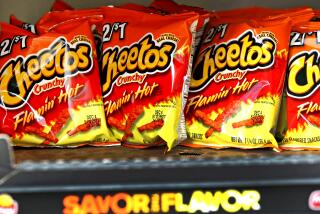How much do American kids love apples? They account for 29% of fruit consumed each day

American kids love apples -- they account for nearly 30% of the fruit they consume on any given day, according to a new study by researchers from the Centers for Disease Control and Prevention.
Skip the açaí berries and pass on the pomegranate juice. When it comes to fruit, American kids prefer apples – by a long shot.
On any given day, apples account for 29% of the fruit consumed by U.S. children and teens, according to a study published Monday by the journal Pediatrics. About two-thirds of that is eaten as whole apples, and one-third is sipped as 100% apple juice.
Kids of all ages rely on apples to fulfill government recommendations to consume up to two cups of fruit per day. Toddlers between the ages of 2 and 5 get 15% of their daily fruit from apples and 17% from juice. Children between the ages of 6 and 11 count on apples for 22% of their total fruit intake and apple juice for an additional 9%. Adolescents in the 12-to-19 age group get 19% of their fruit in the form of apples and 7% from apple juice.
The appeal of apples is apparent across all racial and ethnic groups, consistently taking the top spot among all types of fruit, according to the study. Latino kids get 21.2% of their daily fruit from apples, as do 19.2% of Asian American kids, 18.5% of white kids and 17.2% of African American kids. Apple juice adds an additional 9.8%, 7.7%, 10.4% and 10.5% to those figures, respectively.
NEWSLETTER: Get the day’s top headlines from Times Editor Davan Maharaj >>
The information on apples came from interviews with 3,129 youth (and, depending on their ages, their parents or guardians) who participated in the National Health and Nutrition Examination Survey, which is conducted by the Centers for Disease Control and Prevention. In 2011 and 2012, the kids were asked to recall everything they ate and drank in the previous 24 hours.
The authors of the Pediatrics study, from the CDC’s National Center for Health Statistics, found that just 12 items accounted for 86.4% of all fruit consumed by American kids. In addition to the 18.9% contribution from whole apples and 10.3% from apple juice, the other items were citrus juice (14.3%), other fruit juice (9%), bananas (6.8%), melons (6%), citrus (4.6%), berries (4.3%), peaches and nectarines (3.5%), grapes (2.8%) and dried fruits (0.6%). Other fruits and mixtures of fruit in the form of fruit salad added up to 5.5% of total fruit consumption.
Altogether, the kids who participated in the survey consumed an average of 1.25 “cup equivalents” of fruit on a typical day. Of that, 0.6 cup was eaten as whole fruit, 0.38 cup was drunk as 100% fruit juice and 0.15 cup came from the fruit component of mixed dishes, such as fruit smoothies.
Whole fruit is the most nutritious type of fruit, since it contains fiber along with vitamins and minerals while adding no extra sugars or fat. Whole fruit made up 57% of the total fruit consumed by children between the ages of 6 and 11, compared with 52% for adolescents ages 12 to 19 and 49% for toddlers ages 2 to 5.
The researchers also found differences according to race and ethnicity. With all ages grouped together, Asian Americans got 60% of their total fruit in the form of whole fruit, while the corresponding figure for African Americans was 43%. Latino and white children were in the middle, with whole fruit accounting for 55% of their total fruit consumption.
Follow me on Twitter @LATkarenkaplan and “like” Los Angeles Times Science & Health on Facebook.
MORE SCIENCE NEWS:
Can’t believe your eyes? Scientists build tiny invisibility cloak
‘Amazing’ diabetes drug drives down fatal heart attacks and strokes, study finds
This year’s flu vaccines should work better than they did last year. Here’s why.







